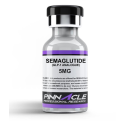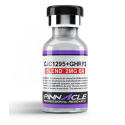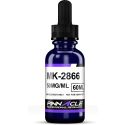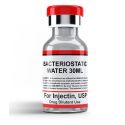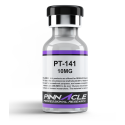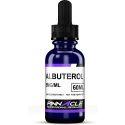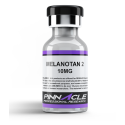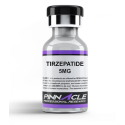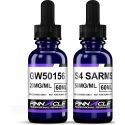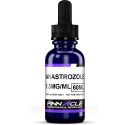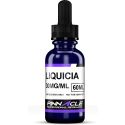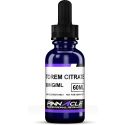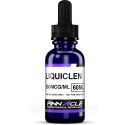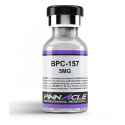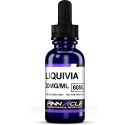Why Peptides Are Key For Treating Aged Skin
This website's contents, articles and product information are all provided purely for educational and informational purposes. The products that are offered on this platform are only meant to be used in in vitro research. The word "in vitro," which comes from the Latin "in glass," describes research that is done outside of a living creature. It is important to remember that these products are not pharmaceuticals or medicines, and the FDA has not approved them for use in the diagnosis, treatment, or prevention of any illnesses or disorders. It is legally forbidden for these goods to be ingested by humans or animals.
Aging skin loses its youthful vitality due to the gradual yet inevitable breakdown of structural proteins like collagen and elastin over time. This manifests visually through wrinkles, sagging, dull tone, and roughened texture. Peptides - short amino acid chains that deliver targeted protein support to skin - are growing in popularity for revitalizing mature skin gently and holistically. Keep reading to understand how peptides address aging at its root causes by renewing collagen density, accelerating natural healing, and stimulating skin’s youthful properties.
Causes Of Skin Aging
Before exploring peptide solutions, it helps to first understand exactly why skin ages from a physiological perspective:
Internal Factors
Aging is an innate biological process affecting all organs over time, including visible changes to our largest organ – skin. Internally, cell activity including skin renewal slows down significantly after age 30.
Skin cell turnover - the constant production of new cells - declines by roughly 1% each year as we get older [1]. When fresh, plump cells replace older ones less frequently, skin looks duller, rougher in texture, and even pigmented.
Hormone changes, especially lower estrogen and progesterone in women, accelerate declining cell metabolism. This differs by gender with women experiencing faster, more noticeable intrinsic skin aging versus men [2].
External Factors
While internal factors govern baseline aging, our daily habits and environment deeply impact the visible aging process:
Sun exposure remains the single biggest contributor to premature skin aging from UV damage accumulating over decades - up to 80% by some estimates [3]! This photoaging adds deep wrinkles, leatheriness, irregular pigmentation, and growths to the mix.
Lifestyle factors like smoking, alcohol consumption, poor sleep, and unmanaged stress interfere with cell repair processes. Insufficient hydration and nutrition also deny skin the essential building blocks and moisture it needs to renew itself.
Pollution, especially microscopic particulates, settles into skin folds and pores, promoting inflammation and collagen breakdown over time [4]. Think fine lines tracing areas covered with face masks.
Harsh ingredients in skin care products or over-exfoliating further attack the skin’s moisture barrier and protective microbiome. This worsens visible signs of aging like redness, sensitivity, and sallowness.
While we cannot stop time or avoid all environmental stressors, understanding root aging causes guides us in caring for skin optimally at each stage of life. This is where peptides enter the picture.
The Skin Rejuvenating Magic Of Peptides
Peptides represent breakthrough anti-aging ingredients that ‘speak the language’ of skin to initiate repair from within using its own renewal processes. Here’s an overview of why peptides have skin specialists excited to slow aging holistically and safely:
What Are Peptides?
Peptides belong to a protein family, consisting of short amino acid chains that are essentially protein fragments or precursors. Chains of just 2-50 amino acids long allow peptides to readily penetrate into deeper layers of skin when applied topically [5].
There, they act as messengers that trigger or shut down biological processes like prompting fibroblasts to ramp up collagen production. Think of signalling one cell type to energize a youth-restoring process lying dormant in aged skin tissue.
Some peptides remain stable alone while others are paired or bound to stabilize the molecule for enhanced delivery. They target a remarkable variety of skin rejuvenation pathways from hydration and anti-oxidation to photoaging interventions.
Peptide Advantages Over Other Anti-Aging Ingredients
The excitement stems from peptides stimulating regeneration intrinsically using skin’s native pathways – safely with minimal adverse reactions. Unlike other cosmeceuticals:
- ✓ Suitable for more skin types and conditions when carefully formulated.
- ✓ Penetrate readily without needing conversion first.
- ✓ Stimulate natural inflammation-free healing and repair processes.
- ✓ Smooth appearance of dynamic wrinkles caused by facial muscle contractions.
Summary of advantages to using peptides versus other common anti-aging cosmeceuticals
Now that we know what they are and why peptides are so unique, let’s explore the most researched and proven peptides for targeting aging concerns.
Most Effective Anti-Aging Peptides
With thousands discovered and created, specific peptides hold the most promise for visibly rejuvenating aged skin based on demonstrated efficacy:
Epithalon
Epithalon is classic Russian-developed peptide regulates telomere maintenance proteins, cortisol-lowering, and protective gene activation pathways to resist cellular aging across bodily systems:
Benefits
- Extends protective telomeres caps on DNA strands
- Lowers harmful elevated cortisol levels
- Enhances immune function and circulating lymphocytes
- Improves reported sleep quality in studies
Sermorelin
Sermorelin stimulates the body’s own growth hormone production to restore youthful tissue repair and metabolic activity:
Benefits
- Increases daytime plasma growth hormone levels
- Reduces body fat percentage while adding lean mass
- Thickens and retextures aging skin
- Deepens sleep quality and duration
Argireline
This peptide based on the botulinum toxin relaxes facial tension leading to smoother appearance of fine lines and wrinkles – especially on the forehead and around the eyes. Effects can appear in as little as a week revealing a ‘Botox-like’ relaxation without paralysing facial muscles [6].
Benefits
- Instantly softens and releases tension driving expression wrinkles
- Up to 30% reduction in wrinkle depth over 15-30 days [7]
- Alternative to neurotoxins for needle-sensitive individuals
Matrixyl
The two Matrikines (Matrixyl 3000 and Matrixyl Synthe’6) in this peptide complex signal skin fibroblasts to stimulate lost collagen I, III, and IV reserves along with elastin, hyaluronic acid, and fibronectin [8]. This rebuilds firmness, density, and elasticity in age-thinned dermal layers.
Benefits
- 117% boost in collagen synthesis in 2 months
- Up to 45% reduction in wrinkle depth in 4 months [9]
- Improves skin tone and lift with consistent use
Copper Peptides
Copper is critical for enzymes driving skin renewal and anti-oxidant defenses which become copper-deficient with age. Combined with various peptides, copper signals reparative and protective processes promoting firmer, younger-behaving skin:
Benefits
- Accelerates wound healing and triggers tissue remodeling enzymes [10]
- Improves skin firmness and texture
- Provides anti-oxidant and anti-inflammatory activity
By selecting complementary peptides working through different mechanisms, we can develop truly synergistic, multi-faceted formulas focused on holistically rejuvenating aged skin.
Peptides vs Retinoids For Anti-Aging Effects
Prescription retinoids (and OTC retinol) provide the gold standard for repairing photoaging and remain unmatched for resurfacing sun-damaged, acne-scarred skin. But in recent years, peptides are emerging as an intriguing contender – potentially even better tolerated long-term.
Both stimulate collagen and glycosaminoglycan production needed to restructure deteriorating skin architecture for improved firmness, smoothness, radiance and elasticity.
However, retinoids irritate and trigger inflammation to renew skin cells which can be too harsh for some. This provokes unsightly redness, peeling, and dryness requiring adjustment periods limiting usage to a few nights weekly at most.
In contrast, peptides coax youthful skin function gently, triggering self-repair processes that lifted appearances naturally without forcing external cell turnover. This makes peptides:
- ✓ Suitable for more skin tones and conditions safely with minimal reactions
- ✓ Better compliance since easily tolerated daily
- ✓ Layerable under retinoids to enhance tolerability and results!
Consider peptides almost like ‘retinoids-lite’ for restoring UV-aged skin health with notably less risk and restrictions – better among those with sensitivity issues. For optimal rejuvenation with fewer side effects, dermatologists now recommend peptides under prescription retinoids to support therapy while lessening irritation.
Which Peptide Format Is Best?
From premium skin care formulations to physician procedures, anti-aging peptides now feature in a variety of formats:
Serums with high concentrations of active peptides offer intensive, fast-penetrating treatment. Lightweight aqueous textures suit all skin types.
Creams/Lotions mix hydratingYet provide peptide renewal targeting wrinkles and elasticity in soothing moisturizing bases. Ideal for dry, aging complexions.
Gels/Essences are refreshing, quickly absorbed options applying peptides in silky thin layers for oily, combination skin.
Sheet Masks deliver boosters through direct contact, often including additional rejuvenating ingredients alongside key peptides.
At clinics, Injectables with muscle-relaxing and volumizing peptides are growing in popularity for non-surgical lifting, contouring and enhancing facial symmetry.
For home use, Argireline Hydrogel Eye Patches allow deeper delivery of this neuromodulator specifically targeting crow’s feet.
Oral Supplements also utilize specialized peptide complexes for glowing skin from within when taken consistently.
As concentrated actives requiring proper formulation, peptides are best utilized before heavier moisturizers which can potentially impact delivery to their receptors within skin.
Serums and light lotions/creams strike an optimal balance between stand-alone treatment yet complementary layers in a complete routine.
Instructions For Using Peptides Effectively
To benefit from their scientifically-proven renewal effects, follow usage and handling tips:
Cleanse - Thoroughly cleanse skin before applying serums or creams so peptides can penetrate efficiently into fresh skin.
Use promptly - Peptides remain extremely delicate molecules best used immediately once exposed to air through opened packaging.
Rotate Daily - Unless recommended otherwise, limit peptide use to once or twice daily ideally alternating routines to avoid overloading receptors.
Pat Gently Until Fully Absorbed - Do not rub harshly onto skin. Instead pat gently allowing 2-3 minutes for complete absorption before following with subsequent products.
Avoid Overheating - Heat and UV exposure degrades peptides rapidly so store away from direct sunlight and high temperatures.
Layer Intelligently - For enhanced hydrating and anti-oxidant activity, apply heavier creams/oils over peptides instead of underneath which may limit delivery.
Following these handling and usage best practices allows peptides to work their magic!
Realistic Treatment Timeframes
While longing for instant transformations, even the most advanced cosmeceuticals require consistent dedication – peptides included!
Managing expectations about visible anti-aging benefits typically seen over the following timeframes helps motivate continual usage for fuller effects:
Immediate Plumping - Instant hydration secondary to humectants in formulas
1 week - Initial muscle tension release and line softening
4 weeks - Improved skin thickness and density
8-12 weeks - Full new collagen synthesis and wrinkle smoothing
3-6 months - Restored firmness, elasticity and lift via repaired extracellular matrix
Like most healthy skin functions, turning back the clock requires patience and regular renewal triggering activity. Prioritize daily gentle cleansing followed by preferred peptide delivery system to enjoy youthfully firm skin texture.
Lifestyle Keys For Optimizing Peptide Results
While peptides can dramatically improve aged skin’s appearance, supporting your ethnic skin health more holistically amplifies their rejuvenating and protective benefits exponentially.
Protect Daily With SPF - Prevent further UV damage driving intrinsic aging plus inhibiting peptides’ renewal work. Reapply every 2 hours outdoors.
Stress Management - Lower cortisol levels impeding collagen metabolism through sufficient sleep, exercise, mindset work.
Targeted Skin Supplements with marine and botanical extracts supporting peptides’ reparative work internally too.
Balanced Nutrition & Hydration - Vibrant skin depends on essential fatty acids, antioxidants and ample water for plumping cells.
By caring for overall health, keeping stress managed, and providing skin the best daily environment possible, anti-aging peptides synergize with supportive habits that enhance glow for the long run.
Conclusion
The science behind peptides offers deeper hope for visibly rewinding skin aging’s clock by rallying our largest organ’s intrinsic capacity to renew, repair and protect itself. As novel signalling molecules that “speak skin’s language”, peptides broadly yet gently coax youthful functioning without irritation associated with many anti-aging cosmeceuticals.
While each peptide approach targets different mechanisms, the most proven peptides stimulate collagen renewal, relax wrinkles, accelerate healing and protective defenses for skin appearing firmer, smoother and more evenly toned after several weeks’ consistent use. Supportive lifestyle measures better equip skin to renew itself maximizing peptides’ reparative effects from both inside and out.
Given most consumers seek gradual rejuvenating options suitable for regular long-term use, peptides represent an exciting anti-ager merging safety, efficacy and flexibility within inclusive skin care. Expect peptide technologies to continue advancing keeping skin youthfully resilient safely.
Referenced Citations
- Baumann L. Skin ageing and its treatment. J Pathol. 2007;211(2):241-251. doi:10.1002/path.2098.
- Makrantonaki E, Zouboulis CC. William J. Cunliffe Scientific Awards. Characteristics and pathomechanisms of endogenously aged skin. Dermatology. 2007;214(4):352-360. doi:10.1159/000101929.
- Ramos‐e‐Silva M, Celem LR, Ramos‐e‐Silva S, Fucci‐da‐Costa AP. Anti‐aging cosmetics: facts and controversies. Clin Dermatol. 2013;31(6):750-758. doi:10.1016/j.clindermatol.2013.05.013.
- Krutmann J, Liu W, Li L, Pan X, Crawford M, Sore G, Seite S. Pollution and skin: an underestimated environmental threat. J Dermatol Sci. 2017;85(3):136-137. doi:10.1016/j.jdermsci.2016.12.004.
- Bukhari SNA, Roswandi NL, Waqas M, et al. Hyaluronic acid, a promising skin rejuvenating biomedicine: A review of recent updates and pre-clinical and clinical investigations on cosmetic and nutricosmetic effects. Int J Biol Macromol. 2018;120(Pt B):1682-1695. doi:10.1016/j.ijbiomac.2018.09.188.
- Blanes-Mira C, Clemente J, Jodas G, et al. A synthetic hexapeptide (Argireline) with antiwrinkle activity. Int J Cosmet Sci. 2002;24(5):303-310. doi:10.1046/j.1467-2494.2002.00153.x.
- Rogiers V. EEMCO guidance for the assessment of transepidermal water loss in cosmetic sciences. Skin Pharmacol Physiol. 2001;14(2):117-128.
- Robinson LR, Fitzgerald NC, Doughty DG, Dawes NC, Berge CA, Bissett DL. Topical palmitoyl pentapeptide provides improvement in photoaged human facial skin. Int J Cosmet Sci. 2005;27(3):155-160. doi:10.1111/j.1467-2494.2005.00263.x.
- Fabi SG, Goldman MP. Comparative study of the effectiveness of three different combinations of synergized glycolic acid, hydroquinone, and natural topical antioxidants versus hydroquinone alone in the treatment of photoaging. J Drugs Dermatol. 2013;12(7):s53-s59.



